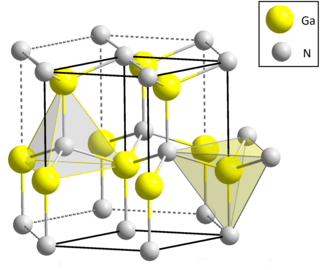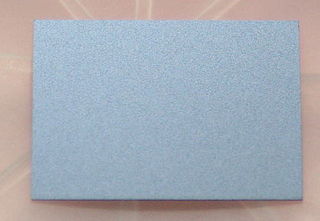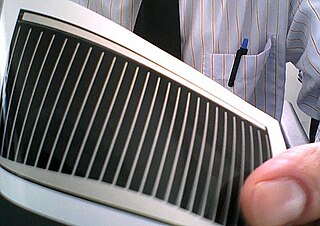Related Research Articles
A semiconductor is a material that has an electrical conductivity value falling between that of a conductor, such as copper, and an insulator, such as glass. Its resistivity generally falls as its temperature rises; metals behave in the opposite way. In many cases their conducting properties may be altered in useful ways by introducing impurities ("doping") into the crystal structure. When two differently doped regions exist in the same crystal, a semiconductor junction is created. The behavior of charge carriers, which include electrons, ions, and electron holes, at these junctions is the basis of diodes, transistors, and most modern electronics. Some examples of semiconductors are silicon, germanium, gallium arsenide, and elements near the so-called "metalloid staircase" on the periodic table. After silicon, gallium arsenide is the second-most common semiconductor and is used in laser diodes, solar cells, microwave-frequency integrated circuits, and others. Silicon is a critical element for fabricating most electronic circuits.

In solid-state physics and solid-state chemistry, a band gap, also called a bandgap or energy gap, is an energy range in a solid where no electronic states exist. In graphs of the electronic band structure of solids, the band gap refers to the energy difference between the top of the valence band and the bottom of the conduction band in insulators and semiconductors. It is the energy required to promote an electron from the valence band to the conduction band. The resulting conduction-band electron are free to move within the crystal lattice and serve as charge carriers to conduct electric current. It is closely related to the HOMO/LUMO gap in chemistry. If the valence band is completely full and the conduction band is completely empty, then electrons cannot move within the solid because there are no available states. If the electrons are not free to move within the crystal lattice, then there is no generated current due to no net charge carrier mobility. However, if some electrons transfer from the valence band to the conduction band, then current can flow. Therefore, the band gap is a major factor determining the electrical conductivity of a solid. Substances having large band gaps are generally insulators, those with small band gaps are semiconductor, and conductors either have very small band gaps or none, because the valence and conduction bands overlap to form a continuous band.

A laser diode is a semiconductor device similar to a light-emitting diode in which a diode pumped directly with electrical current can create lasing conditions at the diode's junction.
Wide-bandgap semiconductors are semiconductor materials which have a larger band gap than conventional semiconductors. Conventional semiconductors like silicon have a bandgap in the range of 0.6 – 1.5 electronvolt (eV), whereas wide-bandgap materials have bandgaps in the range above 2 eV. Generally, wide-bandgap semiconductors have electronic properties which fall in between those of conventional semiconductors and insulators.

Gallium nitride is a binary III/V direct bandgap semiconductor commonly used in blue light-emitting diodes since the 1990s. The compound is a very hard material that has a Wurtzite crystal structure. Its wide band gap of 3.4 eV affords it special properties for applications in optoelectronic, high-power and high-frequency devices. For example, GaN is the substrate which makes violet (405 nm) laser diodes possible, without requiring nonlinear optical frequency-doubling.

Indium phosphide (InP) is a binary semiconductor composed of indium and phosphorus. It has a face-centered cubic ("zincblende") crystal structure, identical to that of GaAs and most of the III-V semiconductors.
Thermophotovoltaic (TPV) energy conversion is a direct conversion process from heat to electricity via photons. A basic thermophotovoltaic system consists of a hot object emitting thermal radiation and a photovoltaic cell similar to a solar cell but tuned to the spectrum being admitted from the hot object.
Aluminium gallium indium phosphide is a semiconductor material that provides a platform for the development of multi-junction photovoltaics and optoelectronic devices. It spans a direct bandgap ranging from ultraviolet to infrared photon energies.

A quantum dot solar cell (QDSC) is a solar cell design that uses quantum dots as the captivating photovoltaic material. It attempts to replace bulk materials such as silicon, copper indium gallium selenide (CIGS) or cadmium telluride (CdTe). Quantum dots have bandgaps that are adjustable across a wide range of energy levels by changing their size. In bulk materials, the bandgap is fixed by the choice of material(s). This property makes quantum dots attractive for multi-junction solar cells, where a variety of materials are used to improve efficiency by harvesting multiple portions of the solar spectrum.
Third-generation photovoltaic cells are solar cells that are potentially able to overcome the Shockley–Queisser limit of 31–41% power efficiency for single bandgap solar cells. This includes a range of alternatives to cells made of semiconducting p-n junctions and thin film cells. Common third-generation systems include multi-layer ("tandem") cells made of amorphous silicon or gallium arsenide, while more theoretical developments include frequency conversion,, hot-carrier effects and other multiple-carrier ejection techniques.
Ben Wang is an American materials scientist who specializes in materials engineering, applying emerging technologies to improve the manufacturing of affordable composite materials. He is a professor at the Georgia Institute of Technology's H. Milton Stewart School of Industrial and Systems Engineering, holds the Eugene C. Gwaltney, Jr. Chair in Manufacturing, and is the Executive Director of the Georgia Tech Manufacturing Institute.
The FAMU-FSU College of Engineering is the joint college of engineering of Florida A&M University and Florida State University. The College of Engineering was established as a joint program serving two universities in Tallahassee, Florida: The Florida Agricultural and Mechanical University, which received recognition from the National Academy of Sciences and the National Academy of Engineering in 2010 for ranking number one as the institution of origin for African Americans earning Doctorates in Natural Science and Engineering; and, Florida State University which has gained worldwide recognition for its extensive graduate and research programs. The college is located less than three miles from either university.

Maria C. Tamargo is a leading Cuban-American scientist in compound semiconductors and materials science. She is a professor of chemistry at The City College of New York.

Multi-junction (MJ) solar cells are solar cells with multiple p–n junctions made of different semiconductor materials. Each material's p-n junction will produce electric current in response to different wavelengths of light. The use of multiple semiconducting materials allows the absorbance of a broader range of wavelengths, improving the cell's sunlight to electrical energy conversion efficiency.

A copper indium gallium selenide solar cell is a thin-film solar cell used to convert sunlight into electric power. It is manufactured by depositing a thin layer of copper indium gallium selenide solid solution on glass or plastic backing, along with electrodes on the front and back to collect current. Because the material has a high absorption coefficient and strongly absorbs sunlight, a much thinner film is required than of other semiconductor materials.
Junqiao Wu is a Chancellor's professor and Department Chair of materials science at the University of California, Berkeley. Wu's materials science research focuses on semiconductors, electronic materials and thermal energy transport. Wu's research in semiconductors has led to major discoveries in the field, such as indium gallium nitride alloys have bandgaps spanning the entire near infrared to ultraviolet spectrum, electrons in vanadium dioxide conduct energy without conducting heat, a temperature adaptive radiative coating that automatically switches thermal emissivity, as well as a range of applications in solar cells, infrared imaging, photonics, and thermoelectrics. He received a BS degree from Fudan University, a MS degree from Peking University, and a PhD degree under Prof. Eugene Haller from UC Berkeley. He received postdoctoral training under Prof. Hongkun Park from Harvard University. His honors include the Berkeley Fellowship, the 29th Ross N. Tucker Memorial Award, the U.C. Regents' Junior Faculty Fellowship, the Berkeley Presidential Chair Fellowship, the US-NSF Career Award, the US-DOE Early Career Award, the Presidential Early Career Award for Scientists and Engineers (PECASE) from the White House, the Outstanding Alumni Award from Peking University China, the Bakar Faculty Fellows Award, elected Fellow from the American Physical Society (APS) and the 2023 John Bardeen Award from the Minerals, Metals and Materials Society (TMS). He is currently on the Chair Line of the Division of Materials Physics at the American Physical Society (APS), and holds joint appointment at the Lawrence Berkeley National Laboratory.

Lisa Marie Spellman Porter is an American materials scientist who is a Professor of Materials Science at Carnegie Mellon University. She works on new ways to process and characterise electronic materials. She has previously served as president of the American Vacuum Society.

Aristos Christou is an American engineer and scientist, academic professor and researcher. He is a Professor of Materials Science, Professor of Mechanical Engineering and Professor of Reliability Engineering at the University of Maryland.
Huili Grace Xing is the William L. Quackenbush Professor of Electrical and Computer Engineering, and Materials Science and Engineering in the Cornell University College of Engineering. In 2019, Xing was elected a Fellow of the American Physical Society (APS) "for pioneering contributions in polar wide-bandgap semiconductors, 2D crystal semiconductors and layered crystals," as well as Fellow of the American Association for the Advancement of Science (AAAS) in 2021.

Srabanti Chowdhury is an Indian American Electrical Engineer who is an associate professor of electrical engineering at Stanford University. She is a senior fellow of the Precourt Institute for Energy. At Stanford she works on ultra-wide and wide-bandgap semiconductors and device engineering for energy-efficient electronic devices. She serves as Director for Science Collaborations at the United States Department of Energy Energy Frontier Research Center ULTRA.
References
- 1 2 3 4 "Faculty & Staff". Georgia Tech.
- 1 2 "Samuel Graham | FAMU FSU College of Engineering". www.eng.famu.fsu.edu. Retrieved 2020-08-28.
- ↑ "NSF Award Search: Award#1410572 - Academic and Research Leadership Symposium for Diversity-Driven Innovation". www.nsf.gov. Retrieved 2020-08-29.
- ↑ "Distinguished Seminar: Samuel Graham, Ph.D., Engineering Interfaces to Improve Thermal Performance of Wide Bandgap Semiconductors". Mechanical Engineering | University of Utah. 2019-10-02. Retrieved 2020-08-28.
- ↑ "Samuel Graham Named New School Chair for Woodruff School of Mechanical Engineering". Georgia Tech College of Engineering. 23 April 2018. Retrieved 2020-08-28.
- ↑ Wrenn, G.E. Jr.; Frame, B.J.; Gwaltney, R.C.; Akerman, M.A. (1996-07-01). "Lightweight composite fighting cover prototype development program". doi:10.2172/464484. OSTI 464484.
{{cite journal}}: Cite journal requires|journal=(help) - ↑ "NSF Award Search: Award#1410572 - Academic and Research Leadership Symposium for Diversity-Driven Innovation". www.nsf.gov. Retrieved 2020-08-29.
- ↑ "Georgia Tech Professor, Researcher Named Dean of Clark School". eng.umd.edu. Retrieved 2021-06-03.